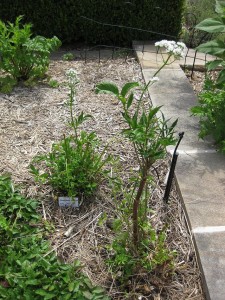 Anise (Pimpinella anisum) is an annual herb that is native to the Mediterranean region and Southwest Asia. The seeds have been in use both as a culinary and medicinal herb for thousands of years. As its name implies, the seeds and the foliage have a distinctive anise flavor.
Anise (Pimpinella anisum) is an annual herb that is native to the Mediterranean region and Southwest Asia. The seeds have been in use both as a culinary and medicinal herb for thousands of years. As its name implies, the seeds and the foliage have a distinctive anise flavor.
Most of us are familiar with its use as flavoring in black jellybeans. It is also used to flavor pfeffernusse and pizzelle. Liqueurs that use anise include ouzo, sambuca, absinthe and pastis. It is even used to flavor some root beers. The Romans made cakes with the seeds which were served after a meal to help with digestion.
Anise has been used to prevent both flatulence and diarrhea. Other medicinal uses include treating upset stomachs and freshening breath.
Anise prefers full sun and moist, well-drained soil. The plants grow to 18 to 24 inches tall. They bloom in mid-summer with white or yellow flowers followed by the distinctive tear drop shaped seeds. Each flower produces 1 to 6 clusters of seed pods each of which contain a total of 6 to 10 seeds. Harvest is easy. When the seed heads have turned brown, simply snip them off and place them in a paper bag to finish drying. Cut slits in the paper bag to ensure good air circulation while your seeds are drying.
Anise is easy to grow from seed. It is best to sow it directly into your garden in the spring because it is difficult to transplant thanks to its long taproot. If you must start your seeds indoors, do so in a biodegradable pot such as a peat pot, which can be planted directly into your garden so as not to disturb the taproot.
Start your seeds indoors 6 to 8 weeks before your last frost. Plant the seeds ¼ inch deep. Germination should occur in 10 to 14 days. You can transplant your seedlings outdoors after all danger of frost has passed and the plants are at least 4 to 5 inches tall. Plant them 12 inches apart.
Direct sowing the seeds in your garden is the best way to grow anise. Plant your seeds ¼ inch deep when the soil has warmed to 70⁰F. Germination should occur in 10 to 14 days. Thin the resulting seedlings to 12 inches apart.

